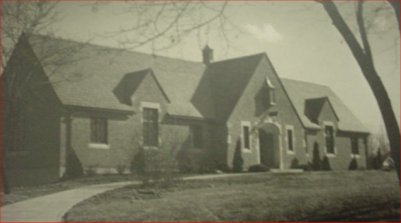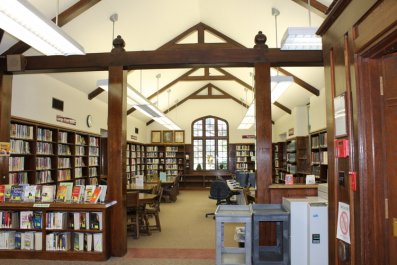

by Leah Konicki

On Valentine's Day 1939, nearly 200 Oakwood citizens toured Wright Library for the first time. Seventy-five years later, on Valentine's Day 2014, a group of Oakwood residents were on hand to celebrate, not only the library's birthday, but its listing in the National Register of Historic Places. The Oakwood Historical Society had worked closely with the library to nominate this important Oakwood building to the nation's list of historic buildings.
Wright Memorial Public Library was included in the National Register as an excellent example of a Tudor or Jacobethan Revival style library designed by the Dayton architecture firm of Schenck and Williams. This firm was responsible for the designs of many of the civic buildings in Oakwood, which, in addition to the library, includes three public schools, the city administration building, and a large-scale apartment building, all in the Tudor or Jacobethan Revival style. The architectural features found on the library that are typical of this style include the multi-paned casement windows in large window bays, the steeply pitched, slate-covered roof, and the stone decoration at doors, windows and gable ends.
The history of Oakwood's library reflects the history of the city itself. Oakwood began to develop in the late nineteenth century as an early streetcar suburb of the city of Dayton. Some development began when an electric streetcar to the intersection known as Five Points was completed in 1895. By 1913, several acres west of Far Hills Avenue had been platted and the area between Irving and Ridgewood Avenues, known as North Oakwood, had been developed by the Schantz family. Oakwood resident and National Cash Register President John H. Patterson encouraged development around his rural estate, the Far Hills, located in what would become Oakwood. Schantz and Patterson each owned large tracts of land and they embraced new twentieth century design principles. The two men hired the nation's leading landscape design firm, the Olmsted Brothers, to help them realize their vision. Schantz worked to build a residential community while Patterson worked to build an estate-style natural retreat by limiting Oakwood's size through the establishment of the Olmstead-designed Hills and Dales Park; Patterson also pushed for Oakwood's incorporation.
Oakwood became a village in 1908, and the development of a local library followed soon after when several city residents came together and donated books. In 1916, room was made for a small library in the newly opened Harman School. This small library was staffed by teachers at first and open to the public only a few hours a week.
Oakwood recognized the growing need for a separate structure for the community library. In 1922, John R. Fletcher, the president of the library board, donated a house he owned at 45 Park Ave to serve as a library. This building was known as the Oakwood Library Building and opened its doors in 1924 with 1500 books and two librarians. By the mid-1930s, however, when prominent Oakwood resident Orville Wright had joined the Library Board of Trustees, discussion began on building a new library. Wright donated $100 to underwrite the expenses of the campaign in support of the bond issue that funded the library, which was approved by voters in 1937.
The library was to be built in a park which was to be named after Orville and Wilbur's sister Katharine. The land on which the library sits is owned by the city; the library has a 99-year lease on the land. The Oakwood Garden Club suggested that the library itself be named Wright Library to honor the three Wrights, an idea that was endorsed by the library's Board of Trustees when they approved the name. Pictures of Orville, Wilbur, and Katharine are on display in the south reading room.
Wright Memorial Public Library was designed by the prominent Dayton architectural firm of Schenck and Williams. The firm designed schools and institutional buildings, commercial and industrial structures, churches, and private residences, including Hawthorn Hill, the Wrights' home in Oakwood. The firm's two principals were Harry I. Schenck and Harry J. Williams. Schenck was a Dayton native; he met Harry J. Williams was a native of Ithaca, New York, at Cornell University, where both were graduates of the School of Architecture at Cornell University. This was the first four-year course in architecture at an American university. Schenck and Williams came to Dayton after graduation where both worked in the architectural office of Frank Mills Andrews. Andrews had also graduated from Cornell University in 1888 and had established a well-known practice in Dayton; Andrews designed the Dayton Arcade as well as several hotels and state capitol buildings throughout the U.S.
Schenck and Williams wanted to establish their own practice, and in January 1906, they partnered to form their own firm. From the beginning, Schenck and Williams were known as the designers to the city's most prominent businessmen, organizations, and institutions. They were Charter members of The Engineering Society of Dayton at a time when the club helped Dayton become recognized as the leading technological city in the country. The Engineering Society of Dayton had started as a social club called the Barn Gang and grew to include famous Daytonians such as Colonel Edward Deeds, Charles F. Kettering, and John H. Patterson. In part because of their association with the Engineering Society, Schenck and Williams became leaders in Dayton's architecture community. The firm won many commissions and was commended for its use of new and creative building materials, including reinforced concrete.
In Oakwood, the firm designed almost all the major institutions in the city, including the Oakwood Junior High and Senior High schools, the Oakwood City Building, Edwin Smith Elementary School, and Wright Memorial Public Library. All of these buildings are examples of the Tudor or Jacobethan Revival style of architecture, popular during the English Tudor-Stuart period. The popularity of the style coincided with Oakwood's development, and, in addition to the institutional buildings, some 30 houses within the three square mile city are in the Jacobethan or Tudor Revival style.

Since its dedication in 1939, the library has been an important and much-loved part of the community. As the city around it, as well as the needs and expectations of the library's patrons, have grown and changed over the decades, so has the building itself. Since it originally opened in 1939, Wright Library has three additions, dating from 1964, 1972, and 1983. The additions and improvements, such as modern air conditioning, have allowed the library to more than double in size and to meet the changing demands for library services. The additions are each respectful of the original structure, and while they are visible from the sides and rear, from the front, the library appears much as it did when it was originally opened to the public in February 1939.
Wright Library was listed in the National Register of Historic Places on December 24, 2013. The National Register was created in 1966 by the federal government to designate districts, sites, buildings, and objects that are important for their history and architecture. There are more than 85,000 National Register listings nationwide, representing over one million historic buildings. The library, which was listed in the National Register for its architecture, joins such notable buildings as Hawthorn Hill and the Schantz House in Oakwood, as well as the Oregon District, the Victoria Theater, and numerous other buildings and districts in Dayton and Oakwood. The nomination was prepared by volunteers from the Oakwood Historical Society which enabled the historical society to provide a public service for this unique community resource. For more information on the National Register of Historic Places, please visit www.nps.gov/nr/.